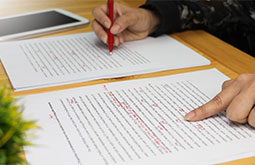10 Professional Tips & Steps to Become an Expert in Typesetting
Typesetting is integral to improving the reading experience. Even when a book has really entertaining and excellent stuff to offer, the presentation of the book is critical. That’s why authors and publishers often typeset their books before printing or publishing.
With typesetting, you can ensure that the content of your books looks excellent. There are many book typesetting service providers that adhere to the best practices to produce excellent quality books. However, if you’re here to learn the tips and practice it yourself, then you’ll find all the information you need in this article.
Let’s start with what is typesetting first.

What is typesetting?
Typesetting is the composition of text by means of arranging physical type in mechanical systems or in digital systems representing characters. In other words, it can be also defined as the process of arranging texts and other interior elements of the book to create the best reading experience for users.
The process usually takes place at the end of book production. The individual responsible to carry out the process is called a typesetter and is responsible for the following jobs.
- Add style to the chapter starts
- Select the right font size and typeface for the content
- Eliminate dangling lines at the end or beginning of the paragraph
- Determine the margin size
- Adjust kerning or spacing between the letters, etc.
skilled typesetter does all of the above to ensure that the content of the book is easier to read and appealing to the human eye.
Types of typesetting
Typesetting can be broadly categorized in two different parts, i.e., Pre-digital era typesetting and Digital era typesetting.
The pre-digital era typesetting is further divided into 3 types, i.e.,
-
Manual Typesetting
Earlier, the system of typography and printing used movable components for reproducing various elements on paper documents. So, in manual typesetting, the movable type was composed with hand by a compositor for each page.
-
Hot Metal Typesetting
The hot metal typesetting process used an in-house casting of the type. Here, the operator used to work on a keyboard or other devices for producing the desired text. This was introduced in the late 19th century as the manual process required more time and effort.
-
Phototypesetting
Phototypesetting was introduced in the early 1960s and resulted in the displacement of continuous casting machines. These were also known as "cold type" systems and used to spin glass, strips, or film disks before a light source for exposing the characters onto a light-sensitive paper selectively.
The digital era typesetting is divided into 4 different types, such as
-
SCRIPT
SCRIPT was introduced in 1970 and helped with processing word and formatting documents with the help of a computer. Later, during the late 1980s, various upgrades were incorporated into the SCRIPT system.
-
SGML and XML Systems
The SGML and XML systems as document models resulted in making other typesetting engines like Penta, Arbortext, FrameMaker, etc. popular. It enabled users to program the SGML and XML typesetting processes by using scripting languages.
-
Troff and successors
The Troff typesetting program was written by Joe Ossanna of the Bell Laboratories in the mid-1970s. It was widely popular for typesetting high-profile computer and technical books. It is still employed in Unix and Unix-like systems.
-
TeX and LaTeX
This is a powerful automated typesetting system created by Donald E. Knuth. It has high standards and can be used to typeset books like mathematics. Tex is difficult to learn and deals with appearance rather than structure. However, LaTex has a simple interface and is easier to encode the document’s structure.
Top typesetting tips & techniques for typesetters to follow
Following are some of the proven typesetting techniques and ideas used by professional companies. If you are aiming to become a typesetter, you should start by laying the foundation strong.
-
Importance of front matter or preliminaries
One of the right things to do while typesetting a book is to take full advantage of the ‘half title page’ and the ‘title page’. Though it may not require much effort to set them right, it can help the book relate to the readers at a personal level even before they start reading the same. ‘Half title page’ contains the name of book and may be the name of author as well. On the other hand, the ‘title page’ includes title, author and publisher of the book. It may sometimes include an illustration. It is an industry practice to make the title consistent in style on all pages including the cover design. An intelligent typesetting service provider would do so.
-
Choose fonts that can easily be understood
Make sure that you choose a readable font; this is one of the basic typesetting rules for books. The term ‘readable’ indicates that the reader should find it comfortable to read them. They should not trouble the eyes of your readers, or make them stressed. Choosing a wrong font will make it difficult for the reader to go through hundreds of pages. You may incorporate fonts like Minion, Caslon, Janson and Garamond, that are generally used in various books all over the world. The eyes of the readers remain along a specific line of type, where the letters are grouped together. This helps them to recognize the words easily. It is important to go for a font that complements the efforts of the readers to finish off the book fast. You may also choose fonts with an even look, without much contrast between the thicknesses of lines in the alphabets. However, you need to select a lively font for the cover, chapter lines, title page and other important areas. The font chosen matters a lot and hence the same must be done only after a proper thought process.
-
Focus on the size of type and leading
After you choose the right font, focus on the typesetting font size in the pages. It should be of optimum size, neither too large, nor too small. Most of the books contain 11-point type fonts. However, it is not mandatory to fix it at 11. You can incorporate variations as and when needed. At times, the type size may look bigger or smaller, due to the differences in font type. On an average, you need to accommodate around ten to fifteen words in a line. However, you need to make an average with the number of words in each line. You also need to focus on the ‘Leading’, the space between subsequent lines. Experts control the leading when they use advanced software like Adobe or InDesign. You may start the process in the auto-setting mode and incorporate changes, as necessary. If the software does not allow you to control the fine-spacing, you need to compare between 1.5 spacing and single-spaced text and choose the one that looks better. In order to mark the differences in their looks, you may get a print out of both the settings on paper and compare. Also, you can learn here to grasp some tips and tricks for typesetting using InDesign software
-
Justification of the pages
Justification is a common practice followed by all typesetting companies to make reading better and to make efficient use of spaces between words on a page. You can attain this easily by using the ‘Justify’ command over a paragraph in Microsoft Word. While taking advantage of this facility as a wise typesetting services provider, you must watch out for ‘rivers of white’ and disturbingly unnecessarily hyphenations. Rivers of white are the unattractive white patterns that run between the lines in a page. If not take care of, it can definitely spoil the reading experience.
-
Indent the initial lines of your paragraphs
Readers should easily be able to locate the beginnings of new paragraphs on the page. It removes the boredom of reading continuous blocks of text. You should indent the first line to a certain extent, which will add variety to the elements in the page. One-fourth inch indent is fine, while half-an inch indent may look too large. Often, web designers and other writers separate two consecutive paragraphs using a blank line. This practice is suitable for text that people view on screen. However, when you deal with a novel, it is advisable to start a new paragraph with an indented first line and this is one among the typesetting fundamentals.
-
Using running heads
Although it is not essential to use a running head, it enhances the book design. Running heads refer to the little headings that come at the top of the key blocks of texts on every page. This helps to anchor the text, enabling the readers to go through the book. The running heads contain various types of information, like the name of the author and the title of the book. At times, the chapter number may also be integrated in the running heads. The headers on left and right-hand pages look different. For instance, the title of the book may appear on the right, while the name of the author may appear on the left. You can also try out other variations, by centering the header or aligning the information inside the margin. In these cases, the page numbers are to be aligned in the exterior margin. Publishers also put the page numbers in the footer in certain cases, below the block of text.
-
Use a blank line to make scene changes
The scenes being depicted by a chapter may have alterations in the middle. A blank line between two consecutive paragraphs will help you to indicate the same. This will enable the readers to understand the change in perspective. For additional measures to incorporate changes in the scenes, you may place a small image or ornament in the middle. You need to make the break a bit wider. Keep it as simple as possible in order to set the desired theme or mood of the book. If you really want to avoid typesetting errors, it’s always advisable to hire exerts offering manuscript formatting services.
-
Hyphenation of the words
Though hyphenation is never avoidable while typsetting a book, if enough attention is given during the typesetting process, most of it can be surely eliminated. If you are keen on eliminating hyphenation, you can do so by moving the entire hyphenated word to the next line by pressing the ‘shift’ and ‘return’ buttons at the same time after placing the cursor in front of the word.
-
Line spacing
It is good to have enough spacing between two lines to read a line independent of the one that lay above and below it. The general rule that many typesetting professionals follow while giving line-space is of ‘2 points. Line spacing also helps to prevent the descenders of the above line from overlapping with the ascenders of the bottom line.
-
A copy-right page
If an author wants to retain the rights to his/her work, as a typesetting services provider you will have to create a copyright page. As there is no standard page with all the pertinent information about the book, its author, publisher and the year of publishing, make a copyright page. Include ISBN and name of the copyright owner and also the statutory declaration.
Special guidelines to achieve a professional looking manuscript!
By keeping a consistent presentation, one can easily achieve a professional outlook for their book. It is very important to maintain the headings and the text’s layout and size intact. The secret is to keep things simple so as to make everything easy. A good design and consistency will help in winning readers’ interest and grab their positive response. There are two typesetting methods for one to proceed:
- By engaging professional typesetting firm or individual typesetter
- By choosing DIY software for typesetting in order to typeset on your own
-
Engaging a professional typesetting company
It exclusively depends upon what kind of book one is writing and how much they are keen on the quality of the product. For example, it is advisable to go for professional assistance if the book is heavy on illustrations.
However here are some tips about DIY tools, for those who are interested to do the typesetting by themselves.
-
Choosing the perfect software for manuscript typesetting
To make matters easier; there are only limited choices among typesetting software to choose from. Here we have put forth those options so that you will know which one is best for you:
The LaTeX: It’s free and an easy typesetting software program which comes with advanced settings. This is the best option when one is formatting documents and non-fiction books, which would involve tables, figures, cross-references or footnotes. However the catch is: It is an open source software; which means one would require to be aware of coding in order to utilize it well.
The Adobe InDesign: This exceptionally impactful typesetting software is mostly preferred by expert designers. But it comes with an exorbitant price tag. The Adobe InDesign is highly adept in stroking, drop cap stylization, kerning, and formatting paragraph, among other things which would otherwise take away exhaustive amount of time if done on a Word. However one would require to have good patience before becoming an expert in using its functions.
Conclusion
Eventually, no matter which option one chooses for typesetting a book for printing, it is highly important to come up with a neat, refined and appealing book that will catch the readers’ attention and keep them engaged from start to finish. Be extra careful to avoid pitfalls of foreign language typesetting as well.
However to ensure that the best page composition services are availed and to stay relived, it is always recommended to entrust the task upon a professional print layout designing company that hires experienced typographers who can execute your project .




